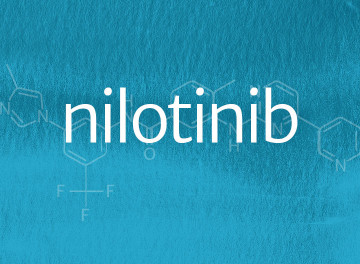You are here
nilotinib

Treatment type:
- Oral therapies
- First line
- Second line
Nilotinib is a derivative of imatinib that was designed to target BCR-ABL1 more specifically than imatinib. It is able to inhibit also most mutated forms with the exception of T315I mutation. When this inhibitor has been used as second-line therapy, the CCyR and MMR were around 50% and 25%, respectively; when employed as firstline treatment, the achievement of CCyR and MMR were deeper, faster and superior to imatinib. The major side effects of nilotinib are elevated bilirubin, aspartate and alanine aminotransferase, lipase and amylase and peripheral arterial obliterative disease. More recently, nilotinib has been associated with an increased risk of cardiovascular events, which tend to occur later in therapy. These cardiovascular events (ischaemic heart disease, ischaemic cerebrovascular events and peripheral artery disease) occurred in between 6 and 12% of patients when the drug is delivered at 300 and 400mg twice daily doses, respectively.